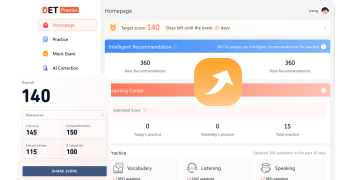Die Beherrschung des Abschnitts „Über das Foto schreiben“ im Duolingo-Englischtest
Der Duolingo English Test hat sich als ein entscheidendes Kriterium für Nicht-Muttersprachler etabliert, die ihre Englischkenntnisse nachweisen möchten. Sein bequemer Online-Zugang und die schnellen Ergebnisse machen ihn besonders beliebt bei Studenten und Berufstätigen, die nach Zulassungen oder Möglichkeiten in englischsprachigen Umgebungen suchen. Ein einzigartiger und herausfordernder Bestandteil dieses Tests ist der Abschnitt „Write About the Photo“, der die Sprachbeherrschung und die Fähigkeit der Prüflinge testet, spontan zu denken und Beobachtungen präzise und klar zu vermitteln.
Dieser Abschnitt präsentiert eine authentische Momentaufnahme des Alltagslebens - eine Szene, an der man vielleicht achtlos vorbeigehen würde. Doch unter dem wachsamen Auge des Tests wird dieser banale Moment zur Leinwand, auf der die Prüflinge ihre Worte malen müssen und die unsichtbare Geschichte mit Präzision und Kreativität darstellen. Innerhalb von nur einer Minute kann die Fähigkeit, ein Foto zu beschreiben, den Grundstein für eine Bewertung legen, die Türen zu Universitäten und Jobchancen auf der ganzen Welt öffnet.
Dieser Beitrag wird Strategien beleuchten, um diesen Abschnitt zu meistern und sicherzustellen, dass Ihre Beschreibung hervorsticht. Wir werden wesentliche Tipps behandeln, um lebendige Beschreibungen zu erstellen, die das Wesentliche des Bildes einfangen und Ihre sprachlichen Fähigkeiten widerspiegeln. Egal, ob Sie ein erfahrener Englischsprecher sind oder Ihre Kenntnisse verbessern möchten, das Beherrschen der Kunst der Beschreibung ist der Schlüssel zum Erfolg im Duolingo English Test.
Bleiben Sie dran, während wir erkunden, wie man ein einfaches Bild in eine Gelegenheit verwandeln kann, den Reichtum Ihres englischen Wortschatzes und die Schärfe Ihrer Beobachtungsgabe zu zeigen.
1. Die Frage verstehen
Die Aufgabe „Write About the Photo“ innerhalb des Duolingo English Test ist so einfach wie tiefgründig. Den Kandidaten wird ein Foto präsentiert und sie sollen innerhalb einer Minute eine Beschreibung dazu schreiben. Während die Anweisungen einfach sind, liegt die Herausforderung in der Ausführung. Dieser Abschnitt geht nicht nur darum, was Sie sehen, sondern auch darum, wie Sie diese visuellen Details durch Sprache interpretieren und vermitteln.
Um die Frage wirklich zu verstehen, muss man erkennen, dass sie einen doppelten Zweck erfüllt. Erstens bewertet sie Ihre sofortige Reaktion auf visuelle Reize und testet Ihre Fähigkeit, Gedanken schnell zu organisieren und in kohärente, beschreibende Sprache zu übersetzen. Zweitens bewertet sie Ihre Englischkenntnisse, insbesondere Ihren Wortschatz, Satzstruktur und Rechtschreibgenauigkeit.
Der Schlüssel zum Meistern dieser Frage besteht darin, Geschwindigkeit und Substanz auszubalancieren. Ihre Beschreibung muss über die bloße Identifikation von Objekten im Foto hinausgehen. Der Test ist darauf ausgelegt, Ihre Fähigkeit zur effektiven Kommunikation zu messen, was den Einsatz variierter Satzstrukturen, reicher beschreibender Sprache und genauer Grammatik beinhaltet. Zum Beispiel sollte die Beschreibung eines Mannes, der einen Hund entlang einer belebten Stadtstraße spazieren führt, sensorische Details, mögliche Emotionen und Handlungen enthalten, die die Szene zum Leben erwecken.
Diese Frage zu verstehen bedeutet, bereit zu sein, sich intensiver mit dem Foto auseinanderzusetzen. Sie sollten bereit sein, nicht nur das Offensichtliche zu beschreiben, sondern auch zu vermuten und darzustellen, was durch die Szene angedeutet werden könnte. Zum Beispiel können die Gesichtsausdrücke der Menschen, das Wetter oder die Atmosphäre des Ortes Kontext liefern, der Ihre Beschreibung bereichert.
Während Sie sich auf diesen Abschnitt vorbereiten, ist Übung entscheidend. Machen Sie sich mit verschiedenen Fotografien vertraut und fordern Sie sich heraus, sie innerhalb der einminütigen Frist zu beschreiben. Dies wird nicht nur Ihre Geschwindigkeit verbessern, sondern Sie auch dazu ermutigen, unter Druck kritisch und kreativ zu denken.
In den folgenden Abschnitten geben wir Ihnen umsetzbare Tipps und Übungen, die Ihre beschreibenden Fähigkeiten verbessern und Ihnen helfen, in diesem einzigartigen und aufschlussreichen Teil des Duolingo English Test zu glänzen.
2. Tipps für eine erfolgreiche Beschreibung
Eine erfolgreiche Beschreibung in der Aufgabe „Write About the Photo“ des Duolingo English Test hängt von einigen Schlüsselstrategien ab. Hier ist, wie Sie sich vorbereiten können, um Beschreibungen zu erstellen, die sowohl effizient als auch effektiv sind:
- Beobachtungsfähigkeiten üben: Verbringen Sie vor dem Test Zeit damit, verschiedene Fotografien zu beobachten und die Details zu notieren, die Sie sehen. Üben Sie, die Essenz des Fotos in eine beschreibende Sprache zu destillieren, die dem Leser ein lebendiges Bild vermittelt.
- Ihren beschreibenden Wortschatz erweitern: Der Reichtum Ihrer Beschreibung hängt weitgehend von der Vielfalt der Ihnen zur Verfügung stehenden Wörter ab. Lernen Sie Adjektive und Verben, die Farben, Formen, Emotionen und Handlungen präzise vermitteln können.
- Ihre Beschreibung strukturieren: Auch unter Zeitdruck kann eine mentale Gliederung helfen. Beginnen Sie mit einer allgemeinen Aussage über die Szene, gehen Sie dann zu spezifischen Details über und enden Sie mit einer interessanten Beobachtung oder einem Kommentar, der einen Abschluss bietet.
- Die Sinne einbeziehen: Konzentrieren Sie sich nicht nur auf das Sichtbare. Erwähnen Sie mögliche Geräusche, Gerüche oder die Atmosphäre des Ortes, um eine multisensorische Beschreibung zu erstellen.
- Schnellschreiben (Tippen) üben: Gezielte Tippübungen können Ihnen helfen, sich an das schnelle Denken und Tippen zu gewöhnen. Verwenden Sie einen Timer, um die Testbedingungen zu simulieren, und überprüfen Sie Ihre Arbeit auf Verbesserungsmöglichkeiten. Sie können Websites wie www.typing.com oder www.keybr.com nutzen, um Ihre Tippfähigkeiten zu üben.
- Häufige Fehler vermeiden: Vermeiden Sie allgemeine Aussagen oder Auflistungen von Gegenständen im Foto. Konzentrieren Sie sich stattdessen darauf, eine Erzählung oder thematische Aussage zu erstellen, die die Elemente miteinander verbindet.
- Vergleichende und metaphorische Sprache verwenden: Vergleiche und Metaphern können Ihrer Beschreibung Tiefe verleihen und fortgeschrittene Sprachkenntnisse zeigen. Zum Beispiel statt „The sky is blue“ könnten Sie sagen „The sky is as blue as a robin’s egg.“
- Grammatik und Zeichensetzung überprüfen: Fehler können die Qualität Ihrer Beschreibung beeinträchtigen. Stellen Sie sicher, dass Sie sich mit grundlegenden Grammatik- und Zeichensetzungsregeln wohlfühlen, um einfache Fehler zu vermeiden.
- Die Bewertungskriterien verstehen: Machen Sie sich mit den Bewertungsmaßstäben vertraut. Zu wissen, was der KI-Bewerter sucht, kann Ihnen helfen, Ihr Üben und Ihre tatsächlichen Testantworten entsprechend zu gestalten.
- Rückmeldungen reflektieren: Wenn möglich, holen Sie sich Feedback zu Ihren Übungsbeschreibungen von Lehrern oder Muttersprachlern. Nutzen Sie deren Erkenntnisse, um Ihren Ansatz zu verfeinern.
Indem Sie diese Tipps in Ihre Vorbereitung integrieren, können Sie den Abschnitt „Write About the Photo“ mit Zuversicht angehen. Denken Sie daran, dass es darum geht, Ihre Englischkenntnisse durch eine gut formulierte Beschreibung zu demonstrieren, die nicht nur zeigt, was Sie sehen, sondern auch Ihre Fähigkeit, klar und kreativ zu analysieren und zu artikulieren, vermittelt.
3. Verbesserung der Lese- und Verständnisfähigkeiten
Lesefähigkeit und Verständnis sind die Grundlage effektiver Kommunikation, insbesondere im Kontext der Aufgabe „Write About the Photo“ im Duolingo English Test. Hier ist, wie Sie diese Fähigkeiten verbessern können, um Ihre Leistung zu steigern:
- Weit und oft lesen: Lesen Sie eine Vielzahl von Materialien, wie Romane, Zeitungen, Zeitschriften und Online-Artikel. Dies wird Sie verschiedenen Schreibstilen aussetzen und Ihren Wortschatz erweitern, wodurch Sie bei der Prüfung aus einem größeren Pool von Wörtern und Ausdrücken schöpfen können.
- Aktives Lesen praktizieren: Machen Sie beim Lesen Notizen zu interessanten Phrasen, ungewöhnlichen Wörtern und ihrem Kontext. Versuchen Sie, die Bedeutungen neuer Wörter aus dem umliegenden Text zu erschließen, bevor Sie sie nachschlagen, um Ihre deduktiven Verständnisfähigkeiten zu verbessern.
- Mit visuellen Medien beschäftigen: Neben dem Lesen beschäftigen Sie sich mit visuellen Medien wie Dokumentarfilmen, Filmen und Fotografien mit Bildunterschriften. Analysieren Sie, wie die visuellen Elemente verbal beschrieben werden, was Ihnen Einblicke in effektive beschreibende Techniken geben kann.
- Karteikarten verwenden: Erstellen Sie Karteikarten für neuen Wortschatz mit Definitionen, Synonymen und einem Beispielsatz. Regelmäßiges Wiederholen dieser Karteikarten kann Ihr Lernen festigen und das Abrufen unter Prüfungsbedingungen erleichtern.
- Zusammenfassungen schreiben: Üben Sie nach dem Lesen eines Artikels oder dem Ansehen eines Videos das Schreiben einer Zusammenfassung. Diese Übung wird Ihnen helfen, wichtige Punkte und Themen zu identifizieren, was wichtig ist, wenn Sie ein Foto betrachten und entscheiden, was Sie in Ihrer Beschreibung hervorheben möchten.
- Besprochenes lernen: Besprechen Sie Ihr Lesematerial mit Freunden oder Lerngruppen. Das Erklären von Konzepten und Diskussionen über Interpretationen kann Ihr Verständnis vertiefen und Ihre Fähigkeit verbessern, komplexe Ideen auszudrücken.
- Konstruktives Feedback suchen: Wo immer möglich, holen Sie sich Feedback zu Ihren schriftlichen Arbeiten. Zu verstehen, wie andere Ihre Beschreibungen interpretieren, kann Sie dabei unterstützen, Ihr Schreiben klarer und wirkungsvoller zu gestalten.
- An Schreibwerkstätten teilnehmen: Nehmen Sie, wenn möglich, an Werkstätten oder Online-Kursen teil, die sich auf Schreibfähigkeiten konzentrieren. Strukturelle Lernumgebungen können wertvolle Anleitungen und Übungsmöglichkeiten bieten.
- Sprachlern-Apps nutzen: Apps wie Duolingo bieten Übungsaufgaben, die Ihre Lese- und Schreibfähigkeiten auf unterhaltsame und interaktive Weise verbessern können. Viele Apps sind so konzipiert, dass sie sich Ihrem Fähigkeitsniveau anpassen, während Sie sich verbessern.
- Beschreibungsübungen durchführen: Setzen Sie sich regelmäßig Zeit, um Ihre Umgebung oder Ihren Tag so detailliert wie möglich zu beschreiben. Dies kann Ihnen helfen, klare und lebendige Bilder mit Worten zu konstruieren, was sowohl Ihre Lese- als auch Ihre Verständnisfähigkeiten verbessert.
Die Entwicklung dieser Fähigkeiten ist ein Prozess, der Zeit und Engagement erfordert. Durch aktives Arbeiten an der Verbesserung Ihrer Lese- und Verständnisfähigkeiten sind Sie besser gerüstet, um die Aufgabe „Write About the Photo“ zu meistern und eine starke Beherrschung der englischen Sprache zu demonstrieren.
4. Beispielbeschreibungen mit Analyse
Für den Abschnitt „Write About the Photo“ wird eine robuste Beschreibung sowohl die Details als auch die Atmosphäre der Szene einfangen. Lassen Sie uns Beispielbeschreibungen der von Ihnen bereitgestellten Bilder aufschlüsseln, um zu sehen, wie dies erreicht werden kann.

*Bild 1: Festliches Hunde-Porträt Beispielbeschreibung: “A Pomeranian dog, adorned with a festive Santa hat and a bowtie, exudes holiday cheer as it nestles within a red gift box. The warmth of the wooden background, adorned with Christmas decor, complements the dog’s joyous expression.”
Analyse:
- Beschreibende Sprache: Wörter wie „geschmückt,“ „strahlt“ und „sitzt“ verleihen der Beschreibung ein Niveau an Raffinesse.
- Aufmerksamkeit für Details: Die Erwähnung der spezifischen Hunderasse und der Art der Dekorationen im Hintergrund malt ein lebendigeres Bild.
- Übermittlung der Atmosphäre: Der Ausdruck „Feiertagsfreude“ setzt die Stimmung des Fotos und lädt den Leser ein, den festlichen Geist zu fühlen.

*Bild 2: Marine-Schiff auf See Beispielbeschreibung: “A formidable naval ship slices through the azure waters, its white hull contrasting sharply against the calm sea. Smoke trails from the ship’s stack, indicating activity aboard this sentinel of the sea.”
Analyse:
- Aktive Verben: „durchschneidet“ und „strömt“ vermitteln ein Gefühl von Bewegung und Aktion.
- Farbkontraste: Die Beschreibung des „weißen Rumpf“ gegenüber dem „azurblauen Wasser“ bietet einen klaren visuellen Kontrast.
- Metaphorische Sprache: Die Bezeichnung des Schiffes als „Wächter“ fügt eine metaphorische Ebene hinzu, die seine Rolle in der maritimen Sicherheit andeutet.

*Bild 3: Vater-und-Töchter-Moment Beispielbeschreibung: “A father, with a gentle smile, embraces his two young daughters against a backdrop of white-washed walls. Their matching gray attire and similar features speak to the familial bond they share.”
Analyse:
- Emotionale Verbindung: Die Beschreibung konzentriert sich auf das „sanfte Lächeln“ und die „Umarmung“, was den emotionalen Aspekt des Fotos hervorhebt.
- Konsistenz im Thema: Die Erwähnung der „passenden grauen Outfits“ und „ähnlichen Merkmale“ verstärkt das Thema von Familie und Einheit.
- Hintergrunddetails: Die Einbeziehung der „weiß getünchten Wände“ bietet Kontext und hält die Beschreibung geerdet.
Jede dieser Beschreibungen berücksichtigt nicht nur das sofort Sichtbare, sondern auch die impliziten Details und Emotionen, die die Bilder vermitteln. Indem Beobachtungen mit interpretativer Sprache verwoben werden, zeigen die Beschreibungen die Fähigkeit, sich über oberflächliche Details hinaus mit dem Foto zu beschäftigen. Das Üben dieser Art von beschreibender Analyse wird Ihnen nicht nur im Duolingo English Test helfen, sondern auch Ihre allgemeinen Kommunikationsfähigkeiten in Englisch verbessern.
Die Kunst der Beschreibung und ihre Auswirkungen auf Ihre Englischkenntnisse
Wie wir durch die verschiedenen Abschnitte und zerlegten Beispielbeschreibungen erkundet haben, ist die Aufgabe „Write About the Photo“ im Duolingo English Test mehr als eine einfache Beobachtungsübung – es ist ein Test Ihrer Fähigkeit, Momente des Lebens in Worte zu fassen, die nachklingen. Es fordert Sie heraus, Ihre Englischkenntnisse auf eine Weise einzusetzen, die sowohl analytisch als auch kreativ ist und die Komplexität der realen Kommunikation widerspiegelt.
Denken Sie daran, dass die Sprachbeherrschung, die durch diese Aufgabe bewertet wird, nicht nur den Umfang Ihres Wortschatzes oder die Richtigkeit Ihrer Grammatik umfasst – es geht auch darum, Ihre Fähigkeit, eine Geschichte durch das Objektiv eines einzigen Bildes zu erzählen. Diese Fähigkeit ist von unschätzbarem Wert, nicht nur um einen Englischtest zu bestehen, sondern um in jeder Umgebung zu gedeihen, in der Englisch das Ausdrucksmittel ist.
Auf Ihrem Weg, die englische Sprache zu meistern, lassen Sie die Praxis der Beschreibung zu einem Tor zu tieferem Verständnis und größerer Flüssigkeit werden. Beschäftigen Sie sich mit Bildern, spielen Sie mit Worten und nehmen Sie die Nuancen der Kommunikation an. Ihre Anstrengungen werden sich nicht nur in Ihren Testergebnissen widerspiegeln, sondern auch in Ihrer Fähigkeit, mit einem globalen Publikum zu kommunizieren und Verbindung zu schaffen.
Wenn Sie sich auf den Abschnitt „Write About the Photo“ vorbereiten, denken Sie daran, über das Sichtbare hinauszusehen und darüber zu schreiben, was Sie fühlen, was Sie ableiten und was Sie sich vorstellen. Die Welt ist ein Mosaik aus Geschichten, die darauf warten, erzählt zu werden, und durch Ihre Beschreibungen haben Sie die Kraft, sie zum Leben zu erwecken.
Klicken Sie hier für weitere DET-Vorbereitungsstrategien
Suchen Sie Tipps für den DET? Finden Sie hier heraus: https://www.detpractice.com/category/pro-test-tips/
Beginnen Sie noch heute mit dem Üben, indem Sie sich kostenlos für unseren DET-Fragenkatalog anmelden.
*Haftungsausschluss: Verwendung von urheberrechtsfreien Beispielbildern
Bitte beachten Sie, dass die in diesem Blogbeitrag verwendeten Bilder urheberrechtsfreie Beispiele sind, die ausschließlich zu Bildungs- und Illustrationszwecken dienen. Sie sind keine tatsächlichen Fotos des Duolingo English Test (DET), und wir sind nicht mit dem DET verbunden oder davon anerkannt. Die bereitgestellten Beschreibungen wurden ausschließlich erstellt, um zu demonstrieren, wie man im Rahmen eines Tests zur Englischkenntnis über ein Foto schreibt. Alle Bilder und Beschreibungen werden verwendet, um Prüflinge auf die Art von Fotos vorzubereiten, die sie antreffen könnten, sowie auf den Detaillierungsgrad und die Analyse, die in ihren Antworten erwartet wird. Für offizielle Übungsmaterialien und Testinformationen beziehen Sie sich bitte auf die offiziellen Ressourcen des Duolingo English Tests.






